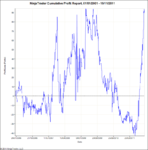This is what I found for original system, do you know any more about it Tomorton? or how you plan to implement it as a strategy?
"Big Ben Strategy is a day trading strategy that takes advantages of the 24-hour trading possibility. It is meant to be used with GBP/USD mainly. According to that you should capture the first directional intraday move after the market opens in London (1am ET). The first big move will usually happen within couple of hours.
While this strategy can be used on the long side as well, it’s mainly meant for short side. Meaning selling short.
The strategy
The market opens and soon (within couple of hours) it makes a new low compared to the opening price, the new low should be at least 25 pips from the opening price. Then the trend reverses and moves at least 25 pips UP from the opening price. This is followed by another short term trend reversal and the price goes below the first low (so more than 25 pips below the opening price). Now you should sell a breakout that is at least 7 pips lower than the first low. Once this has been filled place a stop loss no more than 40 pips above the entry price. Once the price moves lower and lower, also lower your stop limit (half the distance between entry and stop).
And that’s pretty much it. Haven’t tested it myself yet, but will do so soon. If someone has tried it, feel free to share the information in the comments section."
and from elsewhere written differently:
THE BIG BEN STRATEGY
Here’s the story behind Project daily20pip, after this session you will understand why London market is the best time for day trading and why this strategy is so easy even for a forex newbie.
Day trading the foreign currency (forex, FX or interbank) markets is definitely one of the more challenging endeavors an aspiring trader can pursue the higher degree of leverage (as high as 50:1 or 100:1) available in this market can increase profit, but it equally accelerate loss.
This makes the issue of trade timing and selection that much more critical to success Because of the lack of volume data in the spot currency market, newer trader will find they will need to develop much more disciplined strategies that rely less on broader market dynamics and more raw price action and individual market…
The “Big Ben” strategy exemplifies this approach. This suite for day trading technique that takes advantage of the shift from trading from one market centre to another in the 24-hour forex trading environment
The Big Ben Strategy Big Ben is a currency-specific trading strategy designed to captured the first direction al intraday move that often occurs within the first few hours after the Frankfurt/London market openings which begin at approximately 1 am EST or 13.00 WIB.
The strategy woks best with the British pound/U.S dollar (GBP/USD) rate.
Because this currency rate trades lightly outside London trading hours, the surge in trading every morning in the U.K gives it a “real” market opening, which the strategy looks to exploit. Figure 1 shows pound/dollar trading is virtually non-existent during Asian trading hours. When London opens, however, the pound/dollar accounts for nearly one-quarter of all forex trading. Currency rates with more continuous, 24-hour trading will have les of a distinct open/close as they pass through the different money centers. For example, the dollar/yen rate (USD/JPY), which dominates forex activity during Asian trading hours (78 percent of volume), still accounts for 17 percent of trading during European hours. Before explaining the specific logic behind the methodology let’s take a look at what needs to occur for a trade to set up.
The Logic As mentioned. The pound / dollar rate tends to have lower trading volume outside European / London trading hours because the majority of GBP/USD spot deals are worked through U.K and European dealers. This gives the European/British interbank community tremendous insight into the currency pair’s actual supply demand picture.
The Big Ben trade sets up when interbank dealing desks use this intelligence to trigger stops on both sides of market, resulting in new intraday highs and lows. Once these orders are cleared from the books, the market is primed for its first real directional move of the day, which is what the strategy is designed to capture.
The logic behind this trade should be similar with many range breakout strategy used to capitalize on the first real move of the day like our daily20pip strategy with forex signal generator working method with daily pivot calculation.
The rules The following rules are for short traders, but the strategy can be reserved to trade on the long side.
1.The pair makes a new range at least 20 to 25 pips above or bellow the opening price after the early Frankfurt/London trading in the GBP/USD rate begins around 1 am EST.
2.The pair then reverses and trade 20 to 25 pips or more above or bellow the opening price.
3.The pair the reverse once again to trade back bellow the intraday low established in step 1.
4.Sell a breakout (at least seven pips) bellow the London low.
5.Once filled, place an initial protective stop about 30 to 40 pips above or bellow the entry price.
6.After the market moves lower by the distance between the entry price and stop, cover half the position and trail a stop on the remainder.
These simple rules position you to profit from common behaviour that can occur in the pound / dollar when the London / European markets opens.
Trade examples :
Figures 2 shows a Big Ben trade idea on a five minute chart. The first vertical line marks midnight EST. The second vertical line denotes the Frankfurt open and the third line shows when London players begin entering the market. When Frankfurt market opened, the pound / dollar first moved lower, taking out any nearby sell stops. Within 15 minutes of London entering the picture.
However, the market reversed to the upside. The pair was now free to make the first real directional move of the day, and it fell 90 “pips” before buyers stepped in.
If I am not supposed to post this then please remove (but thought useful)😗rolleyes:




